Financial Services
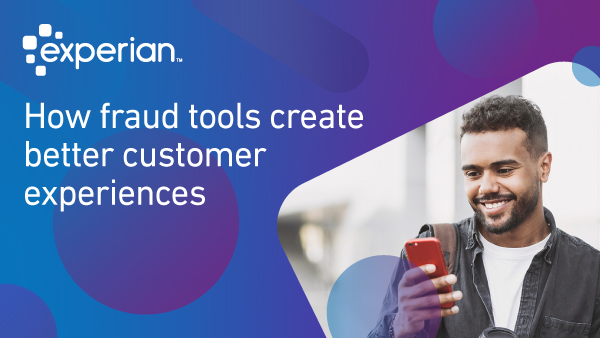
As the economy continues to recover, commercial service providers have a significant opportunity to expand their market share by growing their business and commercial portfolios through new customer acquisition. Compared to consumer relationships, which typically carry a more limited number of accounts, business customers offer the opportunity for a more expansive relationship, with the ability to onboard the customer into multiple accounts and products. A relationship with a business customer may start with a single checking account, and if the customer is pleased with the service and experience, that relationship may blossom with the customer’s adoption of additional products and services including telephone lines and devices, business credit cards, loans and lines of credit for business needs, software, and treasury management products, among many others. To gain more share of the wallet, commercial service providers must offer an excellent digital customer experience as the cornerstone of a successful customer relationship, as the market becomes more and more competitive. Business customers are quickly transitioning their operational processes to be digital-first, and they expect vendors and suppliers, across many industries especially financial institutions, to be a step ahead in offering digital account opening and support. How fraud tools help the customer experience Commercial service providers must continuously innovate their operations and account onboarding strategy to stay competitive and shut out cybercriminals. A robust fraud prevention strategy should help to reduce losses and operational costs. By prioritizing fraud tools that enable automation, commercial service providers can reduce costs by eliminating labor-intensive processes. The challenge for service providers becomes how to effectively manage that trade-off: creating a technology-enabled process that accurately disrupts fraud attempts while not inconveniencing and adding undue friction to legitimate customers. For example, fraud tools that activate during the onboarding phase can help service providers offer a better customer experience, allowing low-risk accounts to pass through with minimal friction while applying safeguards to slow down applicants in the danger zone for further review. Many commercial service providers are unaware of the amount of undiscovered fraud that lies within their customer portfolio. Undiscovered fraud is a subset of your approved customers who represent a risk of future fraud. These cases exist because many legacy fraud tools take a one-size-fits-all approach to screening for fraud. But these customers are at a higher risk for future fraud occurrence. Now, advanced fraud prevention improves the experience for the majority of customers by enabling a less intrusive application process, reducing friction within the customer experience, and increasing operational efficiency. Preventing fraud with an integrated framework of tools There are three major types of application fraud: First-Party Fraud —the perpetrator opens an account without an intent to repay the creditorThird-Party Fraud — the perpetrator opens an account under someone else’s identitySynthetic Fraud — the perpetrator uses stolen information and creates a fictitious identity with pieces of real information, in order to carry out fraud. Tailoring your approach to specific fraud makes for a better customer experience and bottom-line savings. However, identifying and remediating all types of fraud requires a cascade of tools, experts, and data sources. Experian’s commercial fraud suite can be customized within a commercial service provider’s operational workflows to address each form of fraud with the correct treatment. Experian’s tools are supported by the most robust consumer and business data available, in addition to new, third-party sources, giving commercial service providers the ability to gain efficiency through a single partnership, as opposed to manually integrating data from multiple disparate tools and sources. One way we have created efficiencies for commercial service providers is by blending consumer and business data through our next-generation business verification solution Multipoint Verification. It helps clients cross-reference application information with robust databases backed by blended bureau data and new, third-party data sources. With Multipoint Verification, commercial service providers can leverage practical intelligence gathered from signals that describe the validity of attributes like the applicant’s phone number, professional social media profiles, historical employment information; and business information like a business’ web domain, email addresses, mailing address, industry classification, corporate linkage, Tax ID, and much more. Once the business owners have been verified, providers can score their applicants with Experian’s First Party Fraud Score, a new-generation blended predictive scoring model designed to identify first-party fraud risk or the likelihood of a first payment default within the first 6 months of account opening and to identify credit bust-out scenarios. Growing business customer bases with fraud prevention tools Customer expectations of online applications have changed in recent years, and your lower-risk good customers can enjoy that lower friction experience while higher-risk applications get more scrutiny. Focusing on the customer experience in how you screen for fraud can be a great growth opportunity. By using a comprehensive suite of tools such as Experian’s Commercial Entity Fraud Solutions, which specifically addresses each fraud type and applies the right type of friction when needed, your firm can drive operational efficiency that reduces risk and cost. Learn more about Multipoint Verification
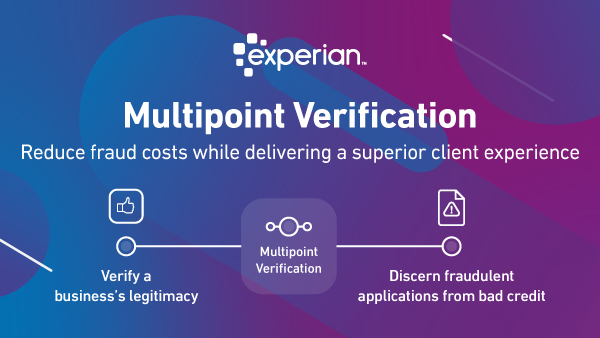
Experian is very excited to unleash game-changing commercial fraud detection capabilities with Multipoint Verification, a key component in our commercial fraud suite. Innovations in digital consumer experiences mean your commercial customers have new expectations. They want personalized, digital, secure faceless experiences, and fast decisions. But faster digital experiences without proper checks can often open the door to commercial fraud. Manual application reviews can slow things down, and cut into your bottom line. Experian can help you control costs and protect you from the high price of commercial fraud, and labor-intensive manual review processes. Multipoint Verification facilitates fraud detection at the point of application, so your lower-risk good customers can continue to enjoy a frictionless experience while you mitigate fraudulent applications. Introducing Experian Multipoint Verification Multipoint Verification helps you verify a business's legitimacy. In addition, it enables you to discern fraudulent applications from bad credit through comprehensive data sets. Single-sourced verification products can be limited in their capability and often prone to false positives. Multipoint Verification arms you with practical intelligence, so you can confirm the linkage between the applicant and claimed business, state filings, email issuance, or identify potential corporate linkage to other entities at the point of application. Experian is transforming the commercial fraud screening landscape, let’s start a conversation. Learn more about Experian Multipoint Verification
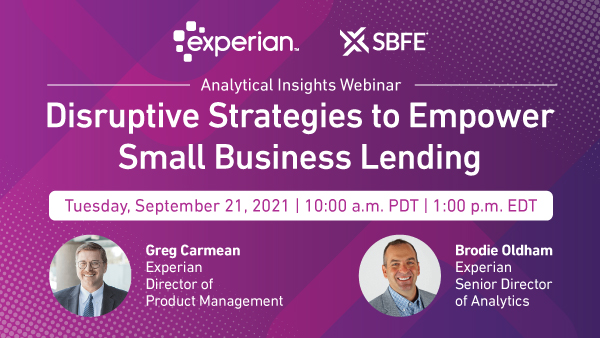
Gain the ability to identify the most stable and profitable small business clients Join our webinar, in partnership with the Small Business Financial Exchange (SBFE): Disruptive Strategies to Empower Small Business Lending Tuesday, September 21, 2021, 10:00 a.m. PDT | 1:00 p.m. EDT Learn how to target small business growth opportunities and enhance the customer experience through automated credit-risk decisioning, with special focus on: Advanced methodologies for developing and leveraging new data attributes Advantages to having explainable, machine-learned models Effortless data visualization to conceptualize growth opportunities Ability to target populations and product mix for financial inclusion Register for Webinar
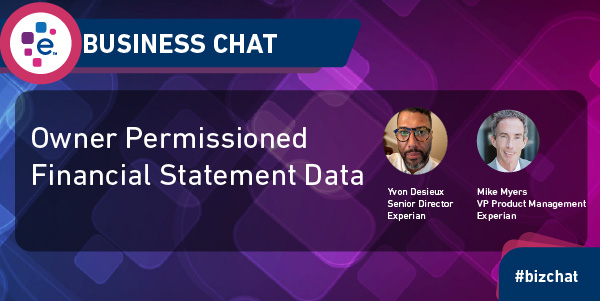
Subscribe To Our YouTube Channel [Gary]: I'm joined by Yvon Desieux, a Senior Director in our product team, and Yvon is responsible for product strategy and driving innovation in lending through the creation of products and applications for commercial lenders. Sitting next to Yvon is Mike Myers, our Vice President of Product Management here in Business Information, and he leads the product team and AgileWorks Innovation Lab. Welcome to Business Chat, gentlemen. The COVID-19 pandemic spurred a wave of innovation in e-commerce, in restaurant delivery services, in FinTech, digital has raised the stakes. There's an expectation with consumers and businesses that client experiences should be on an even playing field across industries. But when it comes to applying for loans, particularly on the commercial side, those processes can be quite manual. One of the things that speed things along is real-time, financial statement data. What is real-time financial statement data? [Yvon]: Well, simply, financial statement data in real-time is just when lenders are able to access accounting software via the Internet, to power their lending decisions, and our new product offering Experian Datashare, provides this capability with the power of owner permission data. With this permissioning, small business owners are empowered with the ability to leverage their own financial data, to apply for the loans and other services that they need. So, unlike a credit report, permissioning puts the owner in control of what transactional data they share, to qualify for the loans and lines of credit that they need to keep their businesses running. So this consented data provides personalization balanced with privacy for businesses and growth, balanced with accountability for the lenders. What problem is real-time financial statement data solving for lenders? [Yvon]: The feedback that we've received falls into four-tier categories. It's revenue growth creating operational efficiencies, decreasing risk, and creating a better client experience through a modern digital journey that's easy to understand and delivers faster decisions and quicker access to the financing that the small businesses need. Mike, when you talk to clients about digital transformation, what are the things that are keeping them up at night? What are they most concerned with? [Mike]: I think all of our clients, to some degree, are going through a technical transformation, or we often call a path to modernization, and Experian is in the same boat. You know, it's hard to stay on top of technology and really leverage the cloud and be able to get new products, new services, new capabilities to market quickly. Some of the biggest challenges our clients expressed to us are how do we operate in what's become a very different environment over the last year, year, and a half with COVID. Things have moved at a much more rapid pace, as far as digitization. So the interactions with their clients have changed. It's become a bit more impersonal. It's become a bit more quick and with a sense of urgency, and many clients are struggling to do everything online and do it at a breakneck speed. This is often where API's and with different technologies, we can keep pace and help our clients integrate data, access data, and ultimately render decisions to their end-users in a much quicker and more time-efficient way. Can you talk a little bit about Experian's API Hub and getting access to our data? [Mike]: The API economy has been here for many years, and our clients are integrating our data and, you know, putting it into their systems so their users can access data real-time. And Datashare is one of those services where this data can be integrated into our client's systems. And there's no drop-off, there's no manual, or swivel chair type activity where you're going to multiple systems. It becomes a much more efficient process. And not only the client wins, but also an applicant gets a much more rapid decision and can go ahead and power their business. Can financial statement data play a role in helping emerging and underserved businesses grow? If so, how? [Yvon]: Yeah, for new and small businesses that haven't yet established business credit and rely on the owner's personal credit profile for lending decisions, Datashare gives them the ability to share their financial statements and show the financial health of the business. This expanded data can be used, in the decision-making process in addition to the standard bureau data to create more approvals. By permissioning data, these businesses are able to move out of an unscorable or subprime, hard money loan bracket, into a space that helps them qualify for more traditional loans and lines of credit, with better rates in terms. [Gary]: Mike, I've got another slide here; businesses of color, have been severely impacted by COVID. You can see some of these stats here. 30% of black business owners say that access to credit is the biggest challenge in the next 12 months. 47% said they didn't apply for financing because they did not think they would be approved, only 37% received all of the financing they sought. Recently on a CBA webinar with a Experian, Janelle Williams from the Atlanta Fed was saying that 83% of the PPP loans went to white-owned businesses, but only 1.9% went to businesses of color. How can Experian DataShare help underserved businesses of color? [Mike]: Yeah, Gary, you're really touching on a key point here. You know, small businesses, power our economy. They make up the majority of businesses out there. And based on that recent stat you and Yvon just discussed about new business startups. There's more than ever, and we all have to do a better job of making sure there's an equal playing field when it comes to accessing capital, whether it's trade credit or financial packages, to help them manage their cash flow. And that became more evident than ever again, with the pandemic and the sudden shift in the economy. It became more and more challenging for many small businesses to manage their cash flow, pay their employees, and really see a path forward. So data share is exciting in a number of ways. What excites me is that it now combines a historical process that was done in a much more offline manual way. And now can be done in real-time. And if you start combining that with historical payment information, historical public record filings, in addition to real-time financials, you have a winning combination that can provide a clear view of a small business's financial status and real-time view. So not only the historical, which is a great way to predict future payment behavior, but also the most current accounts receivable accounts payable information that can really help you understand what their future holds. How can DataShare deepen the relationships between lenders and the small businesses that they serve? [Yvon]: Datashare drives operational efficiency. So, it allows the lenders to receive the financial statement data in a standardized format. This is regardless of the size of the business or the source of the accounting data. It drastically reduces the level of manual effort required to underwrite a loan. And it automates much of the time spent on the administrative tasks associated with the lending process. So this means that relationship managers and underwriters and credit teams are going to spend less time creating reports and gathering documents and chasing clients. And they're going to be able to spend more time holding, we hope, value-driven conversations to deepen the relationships they have with their clients and help those businesses grow and expand in line with their needs. [Gary]: So those small businesses are going to experience greater efficiency, ease of doing business with their lender. The lender has more time to devote and work more closely with those clients, but also maybe the underserved businesses, the unscored businesses, they have that additional insight to see really how that business is doing and how they can grow that relationship with them. Am I right? [Yvon]: Yeah, absolutely. Time is the big commodity, and speed kills. So what Datashare allows lenders to do is negate all of the wasted time and effort spent onboarding and processing clients. And they can dig into that live transactional data, and get to understand the business, and perhaps share insights with the business owners that even the owners don't know. So, it allows both sides to work more efficiently and more profitably. [Gary]: Are you seeing a change in perception on the part of the business owners of today? I mean, a lot of the Millennial business owners they're used to mobile technology, they're used to delivery services on-demand services. Do you see a change in perception in permissioning, access to financial statement data? [Yvon]: Yeah, actually, we have. We typically see adoption rates as high as 90% when it comes to small businesses that are actively looking for financing. So these are motivated clients who typically go with a lender that can provide the quickest time to cash, and Datashare typically cuts down that time to about 65%. We live in a rapidly developing world where digital adoption is at an all-time high, and the same is true for small businesses. As we shift from the stacks of paper and filing cabinets, both lenders and borrowers see the benefits of leveraging technology to make their organizations more efficient and profitable. The annual review process is one pain point that we've heard a lot from clients. Is this something that could help clients minimize some of that pressure, that's a real stressor on bandwidth? [Yvon]: Yeah, absolutely. Datashare automates the monthly, quarterly, or annual review process. So when a small business permissions their data, lenders are able to choose the data refresh frequency, that is also permissioned. So, combined with covenant monitoring Datashare is able to flag accounts that fall out of an agreed risk threshold, which saves the credit team valuable time having to review their entire book of business and allows them to strategically focus on problem accounts and mitigate risk before it gets out of hand. [Gary]: So, any further thoughts on how Experian DataShare can help lenders or the small businesses they serve? [Yvon]: Yeah. Our focus will continue to be on finding ways to automate processes and provide insights into the financial statement data that we acquire. We'll continue to receive feedback from the clients that we've partnered with and integrate that into our roadmap to create new products and services that will benefit both lenders and the borrowers that they serve. [Mike]: Yeah. I would add Gary that we're at a really interesting time. You know, there's the speed and the in-depth view of a small business's financials at our client's fingertips that can help equal that playing field and open up financial opportunities for businesses of all shapes, sizes, and colors, and Experian Datashare helps with that. Combine that with our historical trade and public record data, and you've got a winning solution for both our clients who are offering the financial vehicles, as well as the applicants, the small businesses out there that need help. And that historically may have been on the outside looking in. Now they have an opportunity to share their financial situation, a picture that can help them move their business forward and access capital when they most need it. [Gary]: Well, this has been super informative, guys. I want to thank you for taking the time to come on Business Chat. And if you would like to learn more about how real-time financial statement data can help small businesses, Experian recently published a free ebook perspective paper. We'll provide a link and a QR code for you to download. If you have any questions, of course, feel free to reach out to your Experian account representative to get a conversation started about helping small businesses grow through innovative solutions like Experian DataShare. Thank you very much, gentlemen. Download Perspective Paper Learn more about alternative data Related Posts

The concept of machine learning has been around for 50+ years in analytic circles. But machine learning methods have created a stir in the last few years as their popularity and visibility increased in the U.S. consumer and commercial credit industry. The use of these advanced methodologies has been constrained to mainly fraud/identity and collections. Machine Learning techniques are now available for credit decisioning. Our upcoming Sip and Solve session will provide insights to help your regulator feel more comfortable with the methodology you are using. We will share how Experian is making machine learning explainable to regulators and boosting model performance. During this session you will learn three take-aways: Current model governance basics How machine learning methods are boosting performance Best practices in deployment and documentation to help regulators feel comfortable with this more powerful solution

As business delinquencies rise in response to COVID-19, credit departments are becoming increasingly challenged. In our August 13th Sip and Solve webinar, John Krickus and Andrew Moore will be on hand to share some strategies for maximizing receivables amid rising delinquencies. Managing receivables has never been more important or more challenging. Traditional approaches may no longer apply. In this 15-minute Sip and Solve session, we discuss some solutions for effectively and efficiently handling the increase in receivables many companies are facing. After watching this talk you will learn three key takeaways: Prioritizing receivable management in today's environment Analytic tools for managing receivables Flexing receivables strategies to meet your company's priorities Click to view full slides and transcripts from this session.
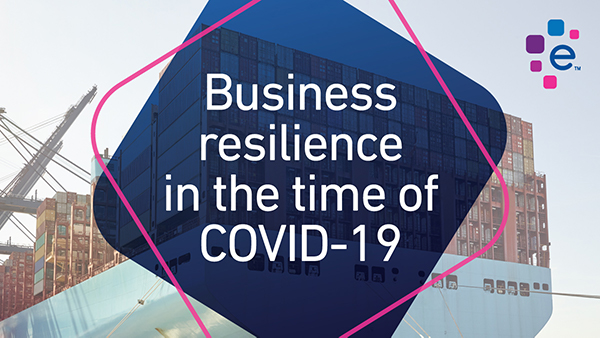
In a favorable economic climate, business resilience is often treated as an afterthought. Success is measured in rapid growth and leaps of progress, while failure is little more than a tempering of that expansion. It’s only when things slow down - like during a global pandemic - that companies are forced to take stock of the ground they stand on. As the economy slows to a crawl and entire industries feel the squeeze, business resilience will determine which organizations make it through to the other side. Whether you’re on the supply side or the demand side, chances are your organization is being tested right now. Here are some practical strategies to stay resilient in the time of Covid-19. Gerard Smith, President of Global Risk Management Solutions (GRMS), works with companies who are either on-boarding new suppliers or evaluating current suppliers. When the Covid-19 pandemic disrupted supply chains in most industries, many of these companies started scrambling to find replacement suppliers. Finding a reliable supplier is always a challenge, but it’s even more difficult during a global pandemic and economic crisis. The best practice here is still to vet new suppliers carefully. Smith’s company creates a risk assessment program for Experian clients that analyzes 50 different financial and legal components, including the following: If they’re on the OFAC sanctions list If they’re financially stable If they actually have the certifications they claim to have If they have insurance If they’ve received negative press Many companies fail to do their due diligence when it comes to suppliers, especially if they’re trying to fulfill orders quickly. More often than not, this leads to bigger problems down the line. If you hire a supplier that’s hemorrhaging money, for instance, they may file for bankruptcy right after you pay them for a major shipment. Companies that use GRMS will be notified regularly if a supplier’s financial or legal status changes. If a supplier cancels their insurance coverage, for example, that could indicate financial struggles. Staying abreast of information like this allows businesses to be proactive with suppliers and avoid being blindsided. Make Sure Clients Are Financially Healthy On the flip side of the buyer-supplier relationship, suppliers are now being asked to extend due dates. Deciding how to comply with these requests can be tricky. Most want to be understanding and reasonable, but there is often legitimate concern over whether they’ll receive payment. Brodie Oldham, Senior Director of Analytic Consultancy for Experian, said Experian offers several services for suppliers who need to gauge how reliable their customers are in this moment. Experian has a special Covid-19 risk index that suppliers can overlay on top of existing credit models. This tool can help determine whether or not a client is in an unstable financial position. If the company operates in a highly impacted part of the country or industry, the supplier can use that information to change the terms. For example, they can sell fewer items to minimize the risk of an unpaid invoice. Experian also monitors credit utilization for business credit cards and other lines of credit. If a company’s credit utilization surpasses a certain threshold, they can alert the supplier who can halt future shipments until the utilization decreases. Find Faster Ways to Evaluate Creditworthiness Many suppliers depend on a company’s credit information to determine its reliability as a buyer. Likewise, credit bureaus are being forced to reevaluate their models in response to the changing business landscape brought on by Covid-19. Enter the agile credit function. The term agile has traditionally been used in the context of software development to describe an iterative approach where requirements and solutions evolve through collaboration between cross-functional teams. It allows companies to adapt to new requests quickly and improve time-to-market. Agile is all about being nimble and responsive - something credit bureaus are prioritizing in today’s uncertain economy. Agile credit means finding new, faster ways of evaluating customers and determining their ability to pay, in a time when that information can change daily. “When everything shut down in March, credit people got thrown for a loop,” said Dan Meder, Vice President of Consulting, Product Marketing and Alliances for Experian Business Information Services. “They needed a way to manage that change very quickly.” That’s where having an agile credit approach comes in. “It’s about using agile principles in your credit function to respond more quickly to changing market needs,” Meder said. Using an agile credit system helps suppliers decide what kind of terms to offer their customers. Many companies are asking suppliers to extend their terms and due dates, often switching from net-30 to net-60. Suppliers then have to decide if they can trust these companies to repay them within that longer time frame, Meder said. If companies in this position use an agile credit function, they can be more responsive and confident in the terms they set out because they’re basing their credit policies on the current state of their customer environment. This requires operating with the latest possible information on how current economic conditions are affecting their customers. Meder said that making credit function more agile requires direction from the head of the credit department and other members of that department. They can also utilize software programmers if the automatic process needs to be updated or any outside consultants for specific analytical expertise. “The idea is to bring together a team of people with direct involvement in managing the credit function to assess how best to manage the customer experience given the current state of the customer environment,” he said. “This includes setting policies around risk assessment as well as credit terms and collection processes.” Meder said companies should have technology that allows them to tinker with their credit function so they can make changes quickly. “This is especially true in a fast-changing or uncertain environment such as what we are seeing with COVID-19 and the uncertain effect it is having on our economy’s future,” he said. “In fact, it is turbulent times such as these where being “agile” is most important since the credit department needs to be able to alter course quickly if the customer environment changes for better or for worse.” Consider Being Flexible With Clients While delayed payments from clients is upsetting, avoid taking your current client relationships for granted. While a more stringent approach from suppliers is understandable right now, Meder cautions companies to remember that the pandemic will end at some point. At that time, companies will remember which suppliers were flexible about payments, due dates and terms - and which companies weren’t. “If you weren’t good to them while they were struggling, they’re going to forget about you when things turn around,” Meder said. To find out how fine-tuning your company’s credit function can help it weather the current economic crisis, reach out to your Experian representative.

Experian® today announced Ascend Commercial Suite™ for financial institutions specializing in commercial lending as well as insurance carriers to drive growth while reducing risk. The suite includes Experian’s Ascend Analytical Sandbox™ configurations and a new Ascend Commercial Benchmarking Dashboard™ that provides access to industry-leading data on small and midsize businesses. “Experian is committed to creating opportunities for businesses to succeed,” said Hiq Lee, president of Experian’s Business Information Services. “During uncertain times, making fast, accurate decisions is critical for lenders so they can continue to extend credit responsibly to the businesses that need it most. Experian’s Ascend Commercial Suite enables clients to access world-class advanced analytics, AI, machine learning, and benchmarking tools so they can make real-time decisions that can ultimately help businesses on the road to recovery ahead.” Experian’s Ascend Analytical Sandbox is an industry-leading cloud-based data and analytics solution that offers flexibility in addressing lenders’ needs and offers instant access to up to 19 years of data. The secure hybrid-cloud environment allows users to combine their own data sets with Experian’s exclusive data assets, including consumer credit, commercial credit, nontraditional, auto, and more. Small and midsize business lenders, as well as insurance carriers, can seamlessly blend commercial and consumer small business data to get a 360-degree view of their overall small business portfolio to more easily identify risks and opportunities. It’s a one-stop-shop for insights, model development, and results measurement. The Ascend Commercial Benchmarking Dashboard delivers a comprehensive visual dashboard view of credit risk data and Small Business Financial Exchange™ (SBFE) Data exclusively for SBFE members. Clients can compare their portfolios against industry performance and analyze new market segments for potential growth and expansion. The insights available through the Ascend Commercial Suite can be viewed and shared through interactive dashboards and customizable reports. Additional use cases include: Portfolio performance and monitoring: Lenders can harness the power of Experian data to better monitor performance and quickly identify areas of strength or concern on visual dashboards without having to run custom reports every month. Model development and validation: Clients can monitor existing models and develop new models in order to improve risk profiles of new accounts and improve existing accounts. Blended analysis: Small business lenders relying on personal guarantees can use both consumer and business data to determine a customer or potential customer’s overall risk. Marketing analytics and acquisition: Lenders’ campaign information and results combined with Experian’s Credit Risk Database help them understand performance and improve marketing and segmentation. Decisioning for risk assessment and segmentation: Lenders and insurance carriers can optimize risk decisioning and segmentation strategies using analytical tools on one platform, which provides quick and efficient access to multiple integrated data sets. Reject inferencing: Lenders can load application data and use SBFE trade-level data to understand how declines performed if customers obtained credit elsewhere. Custom attributes to better analyze portfolios: With SBFE Data, lenders can create their own custom attributes or use Experian’s highly predictive set of attributes. Experian’s Ascend Commercial Suite is built on the Experian Ascend Technology Platform™. Launched in 2017, the Experian Ascend Technology Platform is recognized as one of the most successful launches in Experian’s history. It’s currently being used by the top financial institutions globally including the United Kingdom, South Africa, Brazil and Asia Pacific. Experian’s Ascend Analytical Sandbox was also selected in 2019 as the winner of the “Best Overall Analytics Platform” award by FinTech Breakthrough, an independent organization that recognizes the top companies, technologies and products in the global fintech market. To learn more about Experian’s Ascend Commercial Suite, please visit: https://www.experian.com/business-information/ascend-commercial-suite.
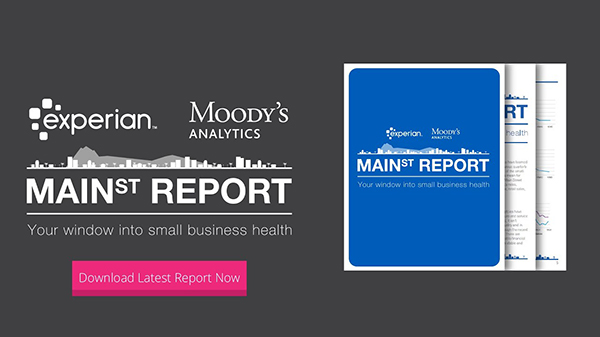
Experian and Moody’s Analytics have just released the Q1 2019 Main Street Report. The report brings deep insight into the overall financial well-being of the small-business landscape, as well as providing commentary on what certain trends mean for lenders and small businesses. In Q1 U.S. small businesses brushed off a government shutdown as stock markets recovered and income gains remained steady. Delinquency rates remained mostly stable, with pockets of weakness spread out among regions and industries, notably agriculture in the Great Lakes and manufacturing in the Southwest. Small firms seem to have simply shrugged off the headwinds of the first quarter and kept on with business as usual. Despite a fresh escalation in trade tensions, the year is starting off well with positive news coming from the areas presenting risks to the outlook. A dovish stance on interest rates from the Federal Reserve and room to grow in our housing market — 2019 is off to a strong start. Watch Webinar Recording - Q1 2019 Quarterly Business Credit Review Listen to the experts from Experian and Moody's Analytics go in-depth on insights revealed in the Q1 2019 Experian/Moody's Analytics Main Street Report.
